rabbitMQ 分享
- 消息中间件使用原因
- rabbitMQ 构成
- 代码简单分析
- 项目展示与debug
消息中间件
案例分析
原始实验室音频组的智能语音平台系统架构组成:
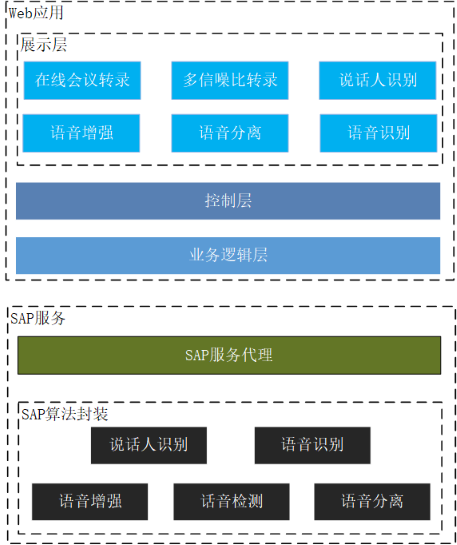
- 包含多个深度学习算法
- 服务端使用springMVC开发,提供用户友好的web界面
- 算法端基于python
- python算法与java服务的交流基于文件
- java后端得到的前端数据存放在文件夹里,python算法端监听,然后进行处理
- 处理完成后的结果存放在文件夹里
- java使用同样的方式读取数据
- 所有服务部署在同一台计算机上
缺点:
- 算法模块与java后端高度耦合(依赖文件夹)
- 多个算法部署在同一台计算机上,计算机处理瓶颈
- 难以应付高负载的业务场景
- 单台服务器宕机系统无法提供服务(分布式)
解决方案:消息中间件
java与python端的交互使用消息的形式,消息可以为任何形式的数据,例如音频,字符串,对象等。java端作为生产者产生消息,算法端作为消费者消费信息,降低了算法和后端的耦合度。同时,消息队列支持集群分布式部署,保证了服务的高可用性。
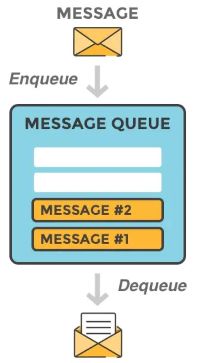
改进后的系统架构和物理架构:
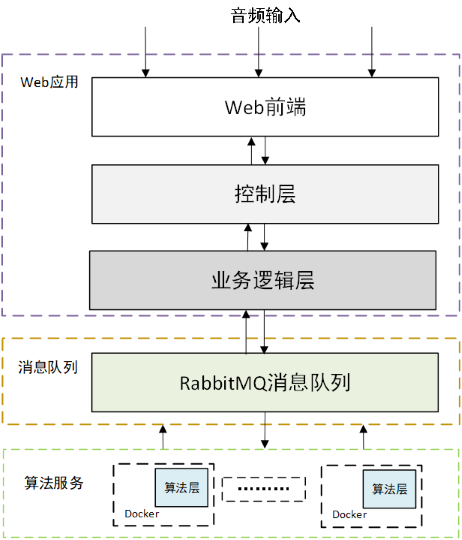
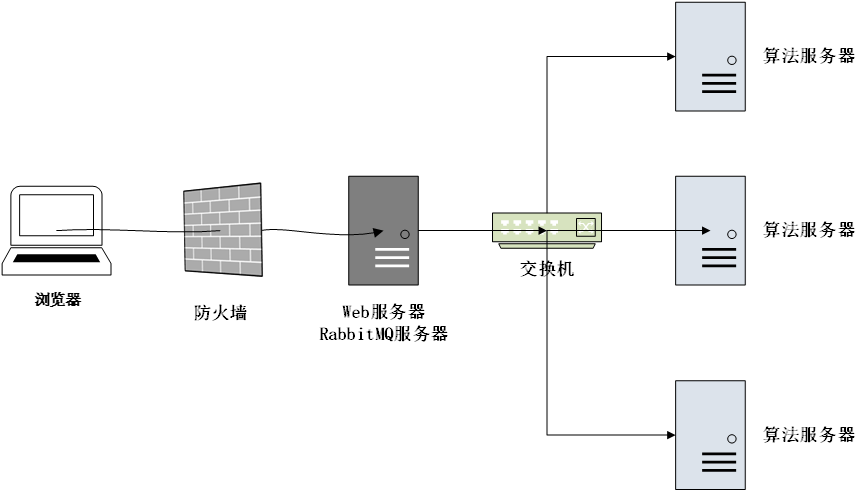
算法部署在多台计算机上,降低服务器的压力,同时同一个算法可以部署多个实例,提高了系统的吞吐率与响应时间。
改进后系统优点
- 解耦(java与算法端不存在较强的依赖关系)
- 流量削峰(消息队列可以缓存消息,从而当算法来不及处理业务时时不会造成系统的崩溃)
- 较为方便的对算法进行水平的拓展,提高单个算法的并行处理能力
- 较高的容错率,当一台算法服务宕机后另一台计算机能够继续提供服务
rabbitMQ构成
当前主流的消息队列有以下几种:
| 特性 | ActiveMQ | RabbitMQ | RocketMQ | Kafka |
|---|---|---|---|---|
| 时效性 | ms 级 | 微秒级 | ms 级 | ms 级 |
| 单吞吐量 | 万级 | 万级 | 10 万级 | 10 万级 |
| 可用性 | 高 | 高 | 非常高 | 非常高 |
| 优势 | 功能极其完备 | 并发能力很强,延时很低,后台管理较为全面 | 分布式,扩展性好 | 大数据领域的实时计算以及日志采集 |
rabbitMQ 结构
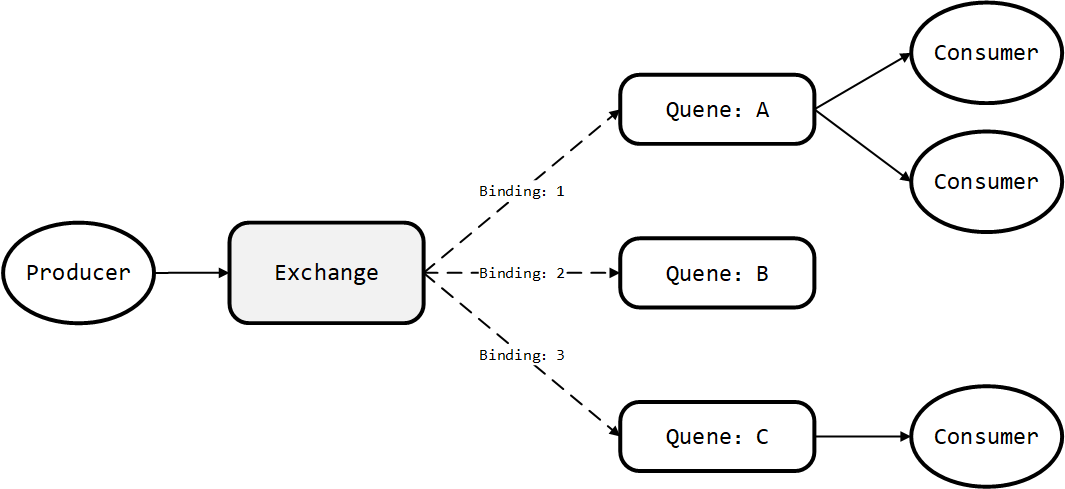
- Producer/Consumer:生产者消费者
- Exchange:交换器,可以理解为队列的路由逻辑,交换器主要有三种
- Direct(单播使用较多)
- Fanout(广播)
- Topic(特定规则)
- Queue:队列
- Binding:绑定关系,实际是交换器上映射队列的规则
RabbitMQ遵循 AMQP协议,RabbitMQ 的 broker 由 Exchange,Binding,queue 组成,其中 exchange 和 binding 组成了消息的路由键;客户端Producer通过连接 channel 和 server 进行通信,Consumer 从 queue 获取消息进行消费。
import time,os,uuid,threading,logging
import pika
import msgpack
def create_connection(host, port, user, password):
credentials = pika.PlainCredentials(username=user, password=password)
connection = pika.BlockingConnection(
pika.ConnectionParameters(host=host, port=port, credentials=credentials))
return connection
class RabbitMQRpcClient(object):
def __init__(self, host, port, user, password, timeout=180):
self.connection = create_connection(host, port, user, password)
self.channel = self.connection.channel()
result = self.channel.queue_declare(queue='', exclusive=True)
self.callback_queue = result.method.queue
self.channel.basic_consume(
queue=self.callback_queue,
on_message_callback=self.on_response,
auto_ack=True)
self._corr_id = None
self._response = None
self.timeout = timeout
def on_response(self, ch, method, props, body):
if self._corr_id == props.correlation_id:
self._response = body
def call(self, call_queue, args):
self._response = None
self._corr_id = str(uuid.uuid4())
body = msgpack.packb(args)
self.channel.basic_publish(
exchange='',
routing_key=call_queue,
properties=pika.BasicProperties(
reply_to=self.callback_queue,
correlation_id=self._corr_id,
),
body=body)
start_time = time.time()
while self._response is None:
current_time = time.time()
if current_time - start_time > self.timeout:
return None
self.connection.process_data_events()
return msgpack.unpackb(self._response)
class RabbitMQRpcServer(object):
def __init__(self, host, port, user, password, service_queue, service):
self.connection = create_connection(host, port, user, password)
self.channel = self.connection.channel()
self.channel.queue_declare(queue=service_queue)
self.service_queue = service_queue
self.service = service
def on_request(self, ch, method, props, body):
msg = msgpack.unpackb(body, raw=False)
response = self.service(msg)
response = msgpack.packb(response)
ch.basic_publish(exchange='',
routing_key=props.reply_to,
properties=pika.BasicProperties(correlation_id=props.correlation_id),
body=response)
ch.basic_ack(delivery_tag=method.delivery_tag)
def start_service(self):
self.channel.basic_qos(prefetch_count=1)
self.channel.basic_consume(queue=self.service_queue, on_message_callback=self.on_request)
self.channel.start_consuming()
class Service(object):
def __init__(self):
pass
def __call__(self, args):
return {'msg': 'hello from service'}
if __name__ == "__main__":
HOST = '127.0.0.1'
PORT = 5672
USER_NAME = 'xxx'
PASSWORD = 'password'
QUEUE_NAME = 'queue name'
# 测试 client
client = RabbitMQRpcClient(HOST, PORT, USER_NAME, PASSWORD)
logger.info(" [x] Requesting")
response = client.call(QUEUE_NAME, {'x': 12})
logger.info(" [.] Got %r" % response)
#测试 Server
service = Service()
server = RabbitMQRpcServer(HOST, PORT, USER_NAME, PASSWORD, QUEUE_NAME, service)
server.start_service()
rabbitMQ官方教程:https://www.rabbitmq.com/getstarted.html
上篇wsl